Garden Designers Roundtable: Designing with Native Plants
Not that long ago, native plants got little respect. They were considered weeds, inelegant scrub, and surely harbored ticks, chiggers, and rodents. Ahead-of-their-time native-plant enthusiasts faced resistance from neighbors concerned about an unkempt look. And even if you did want to grow these plants, you couldn’t find them at your local nursery.
Michael McDowell’s Plano Prairie Garden
We’ve come a long way, baby! Over the past couple of decades, gardening with native plants has achieved not just acceptance but mainstream popularity, driven in some regions by watering restrictions that make gardens full of thirsty exotics unsustainable, as well as a desire to garden with a sense of place. Native plants are now readily available in independent nurseries or online, and shelves of books have been written about gardening with them. Most botanical gardens, it seems, now devote at least some space to native plants, and here in Austin we’re fortunate to have an entire botanical garden, the Lady Bird Johnson Wildflower Center, dedicated to education about and the display of native plants.
Tait Moring’s Austin garden
One aspect of growing native plants, however, continues to lag behind: design. Natives are often used in naturalistic or wildscaped gardens but less commonly, it seems, in more-structured designs, whether formal, clean-lined contemporary, or simply HOA-friendly. Can natives, in fact, be used effectively in non-naturalistic gardens?
You bet. After all, plants are plants, as far as design goes. But here are some tips to keep in mind when using natives to achieve strong design in a central Texas garden.
1. Use broad-leaved plants for structure and contrast. So many of our native perennials here in central Texas, especially sun-lovers, are fine-textured. The tiny leaves that help a plant retain moisture become a blur of undifferentiated foliage very easily. Break up that sea of fine texture with broad-leaved and structural plants like agave, yucca, and spineless prickly pear. Don’t worry—it won’t make your garden look like a desert to have a few of these spiny plants in it. Provided they have good drainage and are grown with other drought-tolerant, sun-loving plants, they mingle quite nicely with flowering perennials and ornamental trees, as in this grouping of Gregg’s mistflower (Conoclinium greggii) and rock penstemon (Penstemon baccharifolius) with nonnative artichoke agave (Agave parryi var. truncata) in Curt Arnette’s southwest Austin garden.
2. Include strong lines in your garden through the use of defined paths, low walls, seating areas, and other hardscape.
A wildscape garden can get by with a stepping-stone path or mulched trail. But if you want a more structured native-plant garden, give it plenty of definition, as in this Glee Ingram-designed garden in west Austin. I don’t mean that you have to spend big bucks on fancy stone terraces or high walls (although those are lovely if you have the means). Defined gravel paths and patios work very well too and have the advantage of being less expensive and easy to install yourself.
And anyone can build a low retaining wall to create an elevation change that adds interest and definition to the garden, as in the Poth-Gill garden in central Austin.
If you need more inspiration, visit the Wildflower Center to see firsthand how to add beautiful structure to native-plant gardens through the use of hardscape.
3. Choose native plants with a long season of interest.
The traditional-garden exotics so often used in gardens across the country are popular for a reason: they are sturdy, long-lasting performers. Of course they may also be water guzzlers and intolerant of our Texas summers, so when you turn to native substitutes, look for those that put on a good show for more than just a few glorious weeks. In Roxanne and Ira Yates’s garden, pictured above, Texas mountain laurel (Sophora secundiflora), Wheeler sotol (Dasylirion wheeleri), and damianita (Chrysactinia mexicana) combine to form a multi-layered, mostly evergreen garden with seasonal flowering.
4. Add focal points to your garden along sight lines.
This is a traditional design technique, and it works just as well in a native garden—maybe better because it adds essential structure—to direct the eye to certain features or indicate where one should walk. Plant an allee of native trees, as Austinite Tom Spencer did with bald cypress (Taxodium distichum)—use an ornamental tree like Mexican plum (Prunus mexicana) if your property is small—drawing the eye inevitably toward a focal-point garden ornament.
Or plant a large pot with a native plant and place it midway along a path so as to stop the eye and encourage visitors to stop and look, as I did with a Texas nolina (Nolina texana) in my former garden.
Cathy Nordstrom-designed garden in northwest Austin
5. Remember that native plants require maintenance, just as traditional exotics do, to look their best.
Natives have been sold so well to the public as bulletproof drought survivors that people often think you can just plant them and walk away. Uh-uh. Not only do native plants require some TLC to get established, just as nonnatives do, they also look better in a garden setting with regular grooming. Have you ever gone hiking on the greenbelt and really looked at the landscape? Is that what you want your garden to look like? I’m not saying a wildscape is bad. I’m just saying that’s not what most people want in front of their houses, especially in traditional neighborhoods.
Rather than let your natives grow “wild” in your garden, take time to prune them as necessary. I don’t mean shearing them into meatballs, mind you, just cutting back dead stems and branches, pruning for shape, pulling up or moving seedlings that are taking over your gravel paths, and giving your garden a cared-for look. Such maintenance is made easier from the start by choosing plants based on their mature sizes, so that you aren’t having to continually clip overgrown foundation shrubs or butcher trees that outgrew their placement.
Take Autumn sage (Salvia greggii) for example. This is a beautiful shrub when in bloom, but it has a tendency to get woody and bloom less if you don’t take the clippers to it. Whack it back by half in late winter (mid-February), and again by one-third in early summer (after the spring bloom) and in late summer (in preparation for fall bloom). It’ll reward you with a tidy shape and a burst of colorful flowers—an asset to your garden.
There you have it—my tricks of the trade for designing with central Texas native plants in a more-structured style of garden. Let me know if you have any other tips that work well too!
This is my contribution to today’s posting on Designing with Native Plants by Garden Designers Roundtable. Click for links to other designers’ posts from around the U.S. and England.
Thomas Rainer : Grounded Design : Washington, D.C.
David Cristiani : The Desert Edge : Albuquerque, NM
Susan Morrison : Blue Planet Garden Blog : East Bay, CA
Rebecca Sweet : Gossip In The Garden : Los Altos, CA
Mary Gallagher Gray : Black Walnut Dispatch : Washington, D.C.
Lesley Hegarty & Robert Webber : Hegarty Webber Partnership : Bristol, UK
Genevieve Schmidt : North Coast Gardening : Arcata, CA
Douglas Owens-Pike : Energyscapes : Minneapolis, MN
Debbie Roberts : A Garden of Possibilities : Stamford, CT
Scott Hokunson : Blue Heron Landscapes : Granby, CT
All material © 2006-2012 by Pam Penick for Digging. Unauthorized reproduction prohibited.


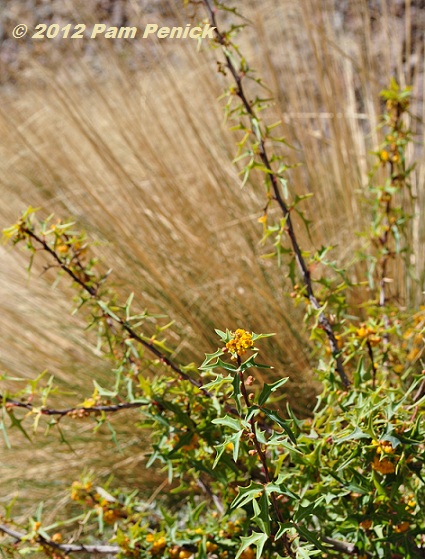
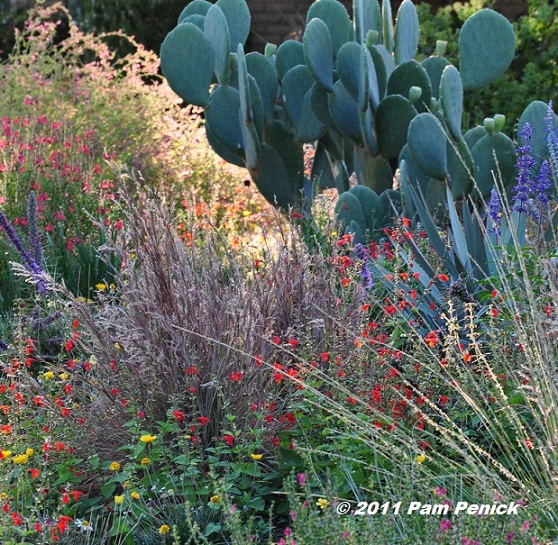
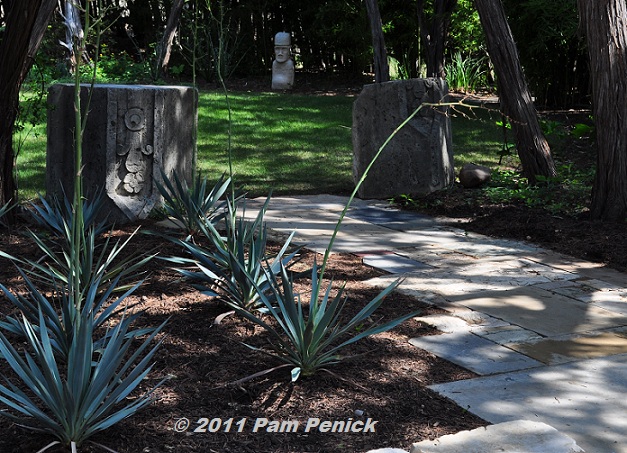
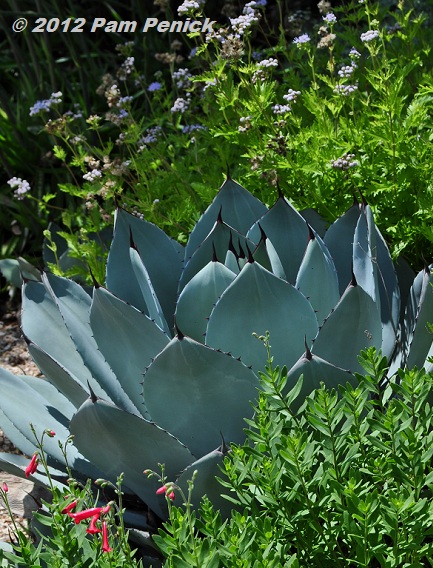
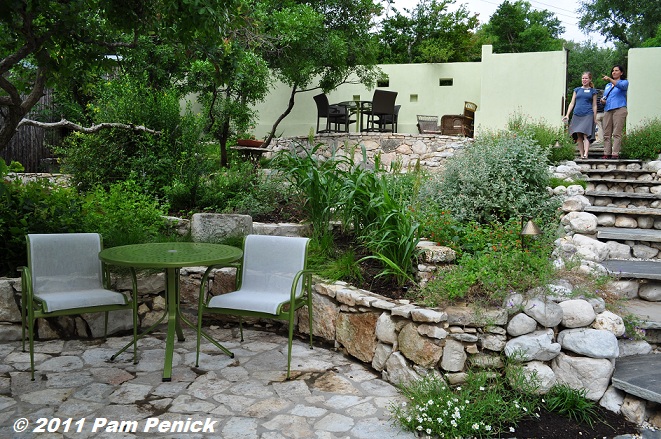
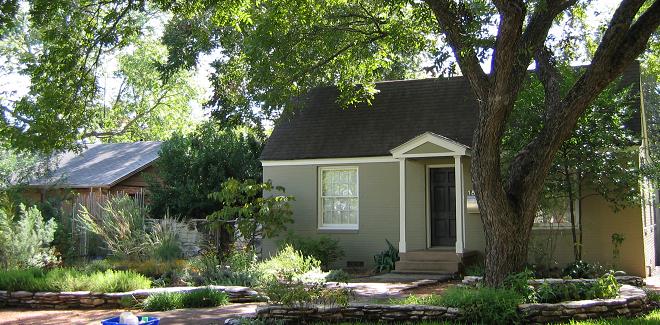
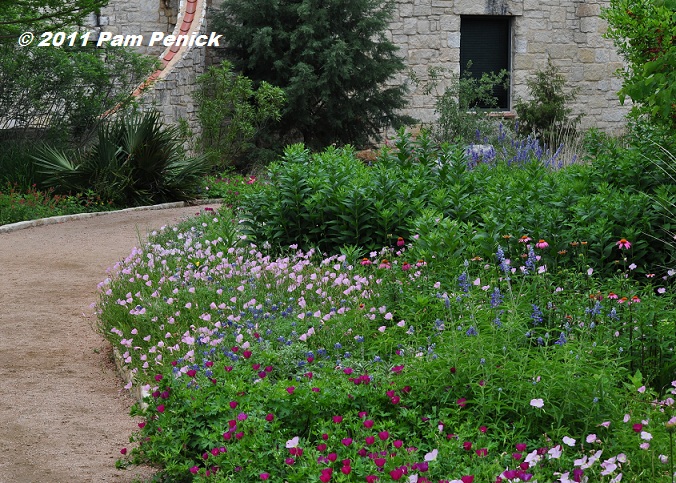
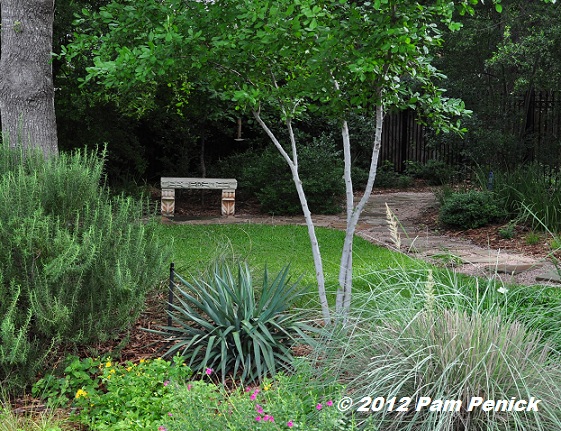
I knew you’d have a great post on this topic, and you did not disappoint. Great examples, and you explanation of how you structure a garden was very thoughtful.
Thanks, Thomas. That means a lot coming from you. Native plants—one of my favorite subjects, no matter the take on it. —Pam
Agree with Thomas. I especially appreciate your advice to include broad-leaved plants for contrast. You are right, so many native gardens are grassy and wispy and lack the “oooomp” that a broad-leaved or more structural plant can offer. Your tips for hardscaping are right on, too!
I’m sure you have an entirely different palette of broad-leaved plants in the mid-Atlantic, Mary. They really do add “ooomp” to the native garden! —Pam
My favorite gardens always seem to include a hefty agave mixed in there somewhere – lucky for me they grow in my climate!! Love your tips, and beautiful photos (your pot with the grass is just stunning!!!!)
Oh, mine too, Rebecca! I didn’t start out loving agaves, but now I’m completely in love and can’t imagine gardening without at least a few. —Pam
Gorgeous photos and good tips here.
Thanks, Darla! I’m glad you enjoyed it. —Pam
Great post Pam! Great tips to be utilized in every garden.
Thanks, Loree. I’m glad you found it useful. —Pam
Nice post. You might be interested in this story recently posted at the Native Plant Society of Texas website. It was written by Carol Feldman, a landscape architect in Dallas who specializes in designing with native plants. She makes some of the same points.
http://npsot.org/wp/story/2012/2821/
Thanks for the link, Bill. I stumbled across Carol’s article just before you left your comment and shared it on the Garden Designers Roundtable Facebook page. It fits in very well with our theme this month! —Pam
You’ve made so many excellent points in this post I don’t even know where to start. But I particularly like the reminder that native plants require maintenance the same way traditional ornamentals do. It still surprises me when clients assume more natives equals less work.
Thanks, Susan. Yes, I felt that was an important point to make, even though it’s not really a design tip. I think natives have been sold so well to the public as a smart choice for drought-stressed climates like Austin’s, with rebates from the city or water utility for installing them, that it’s a natural assumption (though incorrect) that some people think maintenance like watering is not really necessary. —Pam
Great post, Pam! You are singing my song. A couple of additional suggestions:
1. Standard design techniques, such as forced perspective to enlarge or shrink a garden visually, work just as well with native plant gardens.
2. Topographically, horticulturally, and otherwise, Texas is still an extension of northeastern Mexico, even though we are no longer politically joined. So, instead of looking at English language books on gardens, mostly English or northeastern American gardens, Texas gardeners should search out books on Mexican gardens to train their “eyes”.
Excellent point, Peter, especially the second one. Training our eyes, as you put it, is important in learning to appreciate the beauty and variety of our own climate and native plants, and so much better than trying to mimic the soft, lush beauty we see so much of in books and magazines focused on more temperate climates. —Pam
Pam, you must have written this post for me. Great info as usual. I will be reviewing the other Roundtable posts for helpful information as well. I have been thinking of different ways to add more structure and order to my prairie garden. It looks great in the spring and fall when the flowers are in full bloom. I even like the look of the brown grasses in the winter. Summer is a different story. By August, I am afraid my front yard looks like it is filled with a bunch of scraggy weeds. I was planning to temporarily rename my blog Pathetic Prairie Garden this summer but I never got around to putting together a post before the rains came a couple of weeks ago and flowers started to bloom again. I am still going to do a post about my pathetic prairie garden because my little bluestem grasses are dying out and I will not have a prairie before long.
August is a difficult month in most gardens, Michael, so don’t feel too bad—and your garden shines very brightly in spring and fall after all! But if you try adding more structural plants you really can extend your seasons of interest. BTW, I’m sorry to hear your little bluestem grasses are dying out. I just bought some to replace a few miscanthus grasses in my own garden, after being inspired by your fall display last year! What’s wrong with them? —Pam
Hi Pam,
Great to have this structured approach to natives.
It is exactly what would be needed here in uk to get people to use native plants more.
Your point about conventional garden design techniques being used is a good one.
Block planting rather than matrix planting would do it for me.
Thanks and best.
PS love your new pic by the way!
Ironically, aren’t gardeners in the U.K. rather into North American native plants, especially prairie plants? I think you guys appreciated our native plants before we did—you trendsetters you. Great point about block planting rather than matrix. I need to get some photos for examples of that. —Pam
Nice collections of natives with structure, design and contrast. It’s such a challenge to alter the common myth that natives are weedy and dry and need to be used in a desert-like garden with a prairie style.
So true, Diana. I’d love to see more people using natives in bolder, more contemporary style gardens, just for grins. —Pam
Pam, We native plant enthusiasts have come a long way in the past few years, haven’t we? Your photos are so eye-catching and perfectly illustrate how easy it is to incorporate native plants into our gardens.
Thanks, Debbie. Yes, it’s gratifying to see natives being used so extensively these days. —Pam
So many great tips! I really like the emphasis you put on structure…I am focused on that right now. And your tips on pruning salvia greggii….just awesome. Followed your regime this year and it worked like a charm…thank you so much 🙂
Yay, I’m glad to hear it, Heather! Mine are getting ready to burst into bloom again. How about yours? —Pam
Great post, Pam…so true, I think the same principles apply as regular design, as you said…simply throwing some natives out there isn’t really enough. I echo the concern with others that people seem to plant natives because they think they are “done” once they are planted…then they perish in summer. I do need some more plants with substantial foliage…but, unfortunately, my site defies my attempts so far at plants with large leaves…sigh.
Scott, if you’re breaking any design “rules,” it’s working out just fine for you. Your garden is always stunning! —Pam
Thanks for this post. It is exactly what I was looking for.
I’m glad you found it helpful, Kelsey! —Pam
Great post Pam! Thanks for reminding us all that “After all, plants are plants, as far as design goes.” I myself can get too caught up in the eco theme, and forget this simple thought.
Pictures are wonderful, as usual! 🙂
Thanks, Scott. 🙂 —Pam
You’re examples are excellent to keep the bar up; those are universal principles of design, inside, outside, native or adapted plant *problem-solving tools*.
For me, a culture that gets what you state is so key – people into native toughness that gives a place it’s sense. You’re fortunate to live in such a place. It isn’t my job as an LA to educate and inspire people into the best, toughest options to extremes, when it becomes beating a dead horse – and Abq / the desert is as brutal as anywhere. Embracing natives and using them well are both so crucial – all your examples show those plants used well. I wonder how many under the ATX Death Star have been inspired by not just good blogs about people turned on to their flora, but the WF Center displays? (the #s must be huge)
Oh, I’m certain the numbers inspired by the Wildflower Center are huge, and I count myself as one who gardens the way she does thanks to their inspiration. I was also hugely inspired by local garden blogs, namely Soul of the Garden (that’s where my agave interest stems from) and Zanthan Gardens, neither of which is regularly updated these days, although they still have loads of information and inspiration available to anyone who bothers to take a look. —Pam
Thanks for the great information, Pam, as always ! I just acquired four specimens of Greggii and am excited to get them into the garden and see how they overwinter. I hope to see a big show come next late spring. Love it !
Enjoy those salvias! I hope you love them as much as I do. —Pam